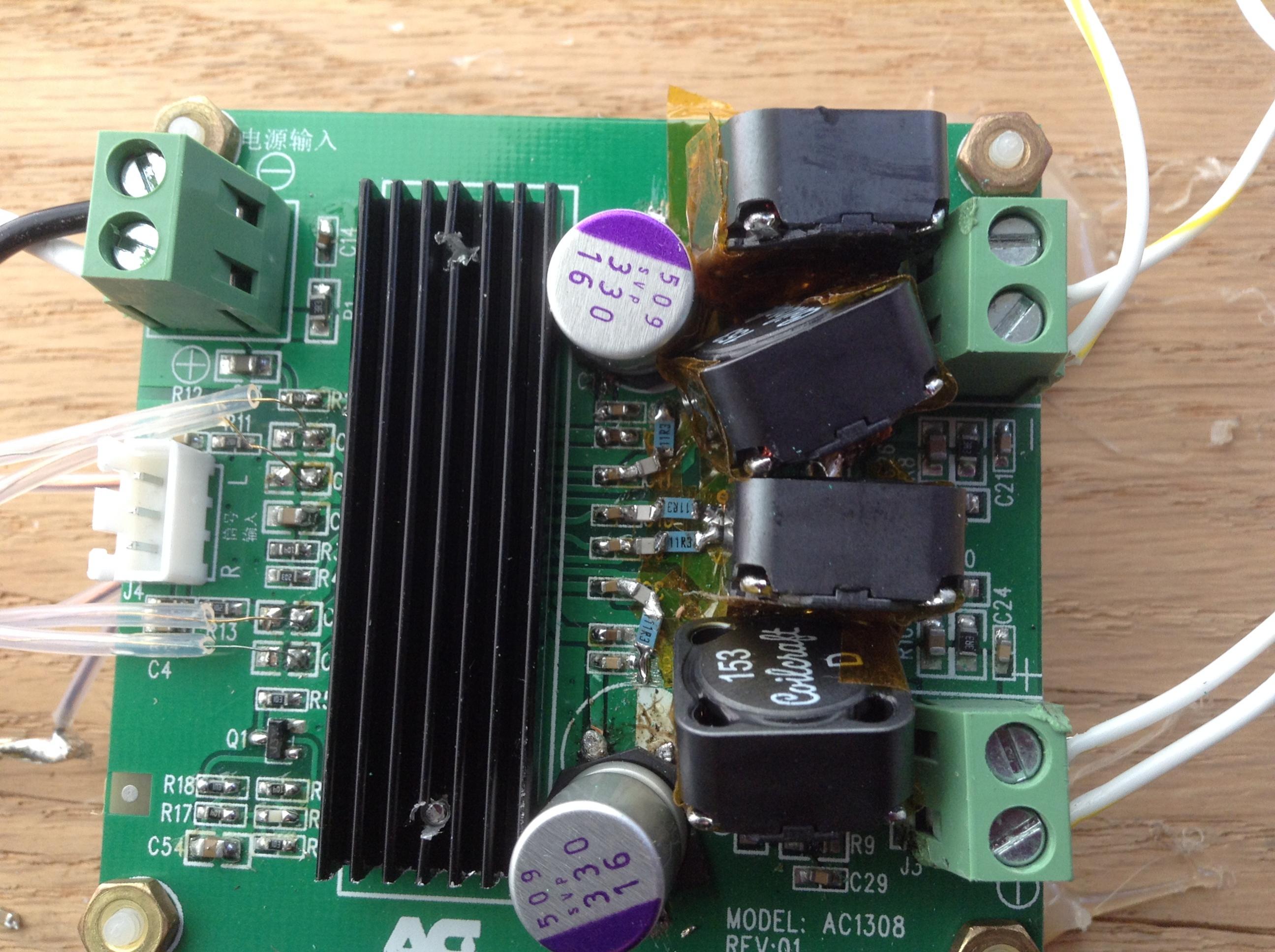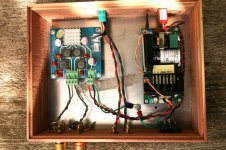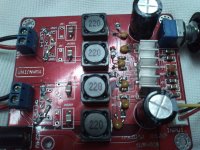Hi,
Buehgemeiste,
Wich model ?
Buehgemeiste,
i have exactly the same psu.
surehifi has lowered the price to € 13.80 incl shipping
Wich model ?
Thanks for your replies. 🙂
I have changed the 2 prong for a 3 prong and grounded it and the amp to the chassis. Will this work?
Looks much safer...just be cautious of ground loop but with star ground this is less an issue...usually
And an additional question: if you put a volt meter across the outputs of your source/pre, and find there is no DC, wouldn't a wire be better than any cap or xformer?
And as a final test, before connecting speakers, put the volt meter across the amp's outputs to confirm there is no DC.
I'm guessing most source components - at least off the shelf stuff - has caps across the outputs. If true, then additional DC blocking at the amp is redundant. Maybe?
If you go straight from dc blocking capacitor to dc blocking capacitor last one being on 3116pcb input, one could remove least specced dc blocking capacitor. One would not need a transformer to replace second dc blocking capacitor. Is that what you mean?
And an additional question: if you put a volt meter across the outputs of your source/pre, and find there is no DC, wouldn't a wire be better than any cap or xformer?
And as a final test, before connecting speakers, put the volt meter across the amp's outputs to confirm there is no DC.
I'm guessing most source components - at least off the shelf stuff - has caps across the outputs. If true, then additional DC blocking at the amp is redundant. Maybe?
I asked a similar question a while back. A lot of DACs these days staes in their specs they have no DC on their output, so why bother with either transformer or cap? The experts answered that a transformer does more than just block DC - it isolates and, in other ways improves the resultant sound.
If you go straight from dc blocking capacitor to dc blocking capacitor last one being on 3116pcb input, one could remove least specced dc blocking capacitor. One would not need a transformer to replace second dc blocking capacitor. Is that what you mean?
Also in that situation, assuming no other components between the DAC output cap and amp input cap, you effectively have 2 caps in series which reduces their overall capacitance 1/C1 + 1/C2 = 1/C3
I added a Mitsubishi 4700uF cap at the power connector location on my modded (YJ blue/black) board today and noticed harshness and more distortion on vocals and at the higher range freq. The board was modded with 10uH toroids, x7r bootstraps caps and OSCON 330uF caps at stock locations. Reason I added the 4700uF is to improve bass.
I do noticed more bass as a result of adding the capacitor. Am I using the wrong capacitor (I don't have any Panasonic FC or FM on hand)? I think I came across someone reporting similar result. Should I better off with adding a few more OSCONs in parallel ?
I do noticed more bass as a result of adding the capacitor. Am I using the wrong capacitor (I don't have any Panasonic FC or FM on hand)? I think I came across someone reporting similar result. Should I better off with adding a few more OSCONs in parallel ?
More OSCONs is fine.
It doesn't have to be directly on the board, can be at PSU. I've been recommending Nichicon KG |||>|| when possible. They're much more neutral and clear than Panasonic FC/FM; straight up better.
It doesn't have to be directly on the board, can be at PSU. I've been recommending Nichicon KG |||>|| when possible. They're much more neutral and clear than Panasonic FC/FM; straight up better.
And an additional question: if you put a volt meter across the outputs of your source/pre, and find there is no DC, wouldn't a wire be better than any cap or xformer?
And as a final test, before connecting speakers, put the volt meter across the amp's outputs to confirm there is no DC.
I'm guessing most source components - at least off the shelf stuff - has caps across the outputs. If true, then additional DC blocking at the amp is redundant. Maybe?
Let me be the devil's advocate. What you described is doing the measurement at standby state - i.e. the pre/source is not working since there is no signal input. But do we know for sure that when there is signals, i.e. when the pre/source is operating, there will not be any DC since none is detected at the standby state?
Regards,
And an additional question: if you put a volt meter across the outputs of your source/pre, and find there is no DC, wouldn't a wire be better than any cap or xformer?
And as a final test, before connecting speakers, put the volt meter across the amp's outputs to confirm there is no DC.
I'm guessing most source components - at least off the shelf stuff - has caps across the outputs. If true, then additional DC blocking at the amp is redundant. Maybe?
Oh, I recalled that (please correct me if I am wrong) there is a 3 V (DC I presume) bias across the input cap. There had been some discussion on whether using a transformer with a DC voltage present might cause saturation of the transformer core. I do not remember the details anymore. Would some one please clarify?
Regards,
There is a 3VDC bias. In single-ended mode, you need the caps for DC blocking. In balanced mode, the 3VDC is balanced on the "+" and "-" differential inputs per each channel, so they cancel out; hence, making it fine to use input transformers without caps.
If you have a source with balanced outputs, you might be able to directly connect the balanced outputs directly to the corresponding differential inputs of the TPA3116 amp without any caps. But this also depends on the output impedance of the source, and how it compares to the input impedance of the TPA3116 amp.
I used the CineMags since I wanted to have the flexibility of using single-ended sources and take advantage of the differential inputs to reduce the noise floor and remove the caps. I do need to insure that the source component has DC blocking caps before connecting the source to my amp.
If you have a source with balanced outputs, you might be able to directly connect the balanced outputs directly to the corresponding differential inputs of the TPA3116 amp without any caps. But this also depends on the output impedance of the source, and how it compares to the input impedance of the TPA3116 amp.
I used the CineMags since I wanted to have the flexibility of using single-ended sources and take advantage of the differential inputs to reduce the noise floor and remove the caps. I do need to insure that the source component has DC blocking caps before connecting the source to my amp.
I used the CineMags since I wanted to have the flexibility of using single-ended sources and take advantage of the differential inputs to reduce the noise floor and remove the caps. I do need to insure that the source component has DC blocking caps before connecting the source to my amp.
But the transformer does block any DC if present from the source surely?
My modded Audiobah board.
Lundahl input transformer (in my DAC) and removed input caps, oscon power supply caps, bootstrap cap/resistors out and output inductor mod.
BTW, I am feeding it 12VDC from an Astron power supply, which is why I can get away with 16VDC oscons.
Sounds very nice now 🙂
hi randytsuch
Does the Audiobah board uses correct bootstrap capacitor value 0.22uF in stock mode ???
You said that you change the caps or bootstrap snub mod ???? I'm kinda confuse sorry... 😕

Last edited:
But the transformer does block any DC if present from the source surely?
No. The transformer cores will saturate.
I added a Mitsubishi 4700uF cap at the power connector location on my modded (YJ blue/black) board today and noticed harshness and more distortion on vocals and at the higher range freq. The board was modded with 10uH toroids, x7r bootstraps caps and OSCON 330uF caps at stock locations. Reason I added the 4700uF is to improve bass.
I do noticed more bass as a result of adding the capacitor. Am I using the wrong capacitor (I don't have any Panasonic FC or FM on hand)? I think I came across someone reporting similar result. Should I better off with adding a few more OSCONs in parallel ?
Maybe the Oscons didn't solve YJblue harshness, but only masked it.
No. The transformer cores will saturate.
so, you should not use signal ground of the tpa3116 with a transformer input?
RED YJ TPA 3116 BOARD--MY EXPERIENCE
After reading so many glowing reports of the board , I decided to learn SMD soldering by modding this board.
I thought the pcb quality is OK but the caps used are of dubious quality as expected for a board of this price.
I change nearly all the caps on this board and substitute with x7R caps and COG caps bought from element14.
Input caps are 2.2UF x7r caps. The existing 1UF caps are in fact very good and compliment the chip well with a very silky mid range
The power caps are replaced with Nichicon VZ 1500 uf.
TPA 3116 is very sensitive to low value x7R bypass caps placed as close to the chip as possible. I add 331 COG bypass caps and the resulting sound is much clearer and enhance treble realism.
The original YJ red board use different value post inductor R and C filter values . Changing to the evaluation board values should be performed as the first step in the mod of the board. I follow the evaluation board pre and post inductor filter values . This change results in obvious sound improvement.
The next change the .22Uf bootstrap caps to better quality ..
Bypass the 1UF cap on the GVDD pin with 331 COG cap results in discernible improvement in stability of the soundstage.
About a half a dozen of my friends have auditioned it and everyone is impressed. The typical comments is very stable deep and wide sound stage and very balanced high,mid and low frequency. Despite the fact I am using the markaudio 12P fullranger , everyone commented on the tunefulness of high quality of the bass.
Thanks to everyone who share their experience on this thread.
My next mod is the inductor change.
kp93300
After reading so many glowing reports of the board , I decided to learn SMD soldering by modding this board.
I thought the pcb quality is OK but the caps used are of dubious quality as expected for a board of this price.
I change nearly all the caps on this board and substitute with x7R caps and COG caps bought from element14.
Input caps are 2.2UF x7r caps. The existing 1UF caps are in fact very good and compliment the chip well with a very silky mid range
The power caps are replaced with Nichicon VZ 1500 uf.
TPA 3116 is very sensitive to low value x7R bypass caps placed as close to the chip as possible. I add 331 COG bypass caps and the resulting sound is much clearer and enhance treble realism.
The original YJ red board use different value post inductor R and C filter values . Changing to the evaluation board values should be performed as the first step in the mod of the board. I follow the evaluation board pre and post inductor filter values . This change results in obvious sound improvement.
The next change the .22Uf bootstrap caps to better quality ..
Bypass the 1UF cap on the GVDD pin with 331 COG cap results in discernible improvement in stability of the soundstage.
About a half a dozen of my friends have auditioned it and everyone is impressed. The typical comments is very stable deep and wide sound stage and very balanced high,mid and low frequency. Despite the fact I am using the markaudio 12P fullranger , everyone commented on the tunefulness of high quality of the bass.
Thanks to everyone who share their experience on this thread.
My next mod is the inductor change.
kp93300
Attachments
- Home
- Amplifiers
- Class D
- TPA3116D2 Amp




